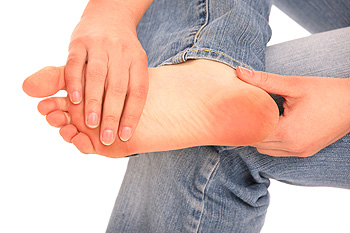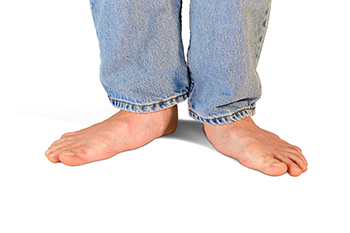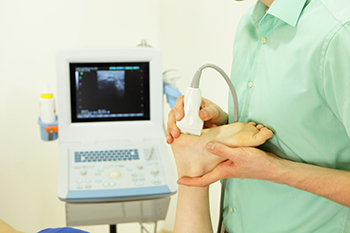Items filtered by date: September 2021
Pain in the Arch of the Foot
 The arch is located near the middle of the sole of the foot. Most people have visible arches that curve upwards and can be seen even when the foot is bearing weight. Some people have flat feet, with either no arches or arches that are only visible when the foot is not bearing weight. Regardless of whether or not you have flat feet, anyone can experience pain on the bottom of the foot in the arch area. The most common cause of arch pain is plantar fasciitis, a condition in which the ligament that runs along the bottom of the foot becomes inflamed due to injury. Other potential causes of arch pain include foot cramps, plantar fibromas, tarsal tunnel syndrome, posterior tibial tendonitis, stress fractures, and acquired flat feet. For more information about arch pain, please consult with a podiatrist.
The arch is located near the middle of the sole of the foot. Most people have visible arches that curve upwards and can be seen even when the foot is bearing weight. Some people have flat feet, with either no arches or arches that are only visible when the foot is not bearing weight. Regardless of whether or not you have flat feet, anyone can experience pain on the bottom of the foot in the arch area. The most common cause of arch pain is plantar fasciitis, a condition in which the ligament that runs along the bottom of the foot becomes inflamed due to injury. Other potential causes of arch pain include foot cramps, plantar fibromas, tarsal tunnel syndrome, posterior tibial tendonitis, stress fractures, and acquired flat feet. For more information about arch pain, please consult with a podiatrist.
Plantar fasciitis is a common foot condition that is often caused by a strain injury. If you are experiencing heel pain or symptoms of plantar fasciitis, contact Leonora Fihman, DPM from California. Our doctor can provide the care you need to keep you pain-free and on your feet.
What Is Plantar Fasciitis?
Plantar fasciitis is one of the most common causes of heel pain. The plantar fascia is a ligament that connects your heel to the front of your foot. When this ligament becomes inflamed, plantar fasciitis is the result. If you have plantar fasciitis you will have a stabbing pain that usually occurs with your first steps in the morning. As the day progresses and you walk around more, this pain will start to disappear, but it will return after long periods of standing or sitting.
What Causes Plantar Fasciitis?
- Excessive running
- Having high arches in your feet
- Other foot issues such as flat feet
- Pregnancy (due to the sudden weight gain)
- Being on your feet very often
There are some risk factors that may make you more likely to develop plantar fasciitis compared to others. The condition most commonly affects adults between the ages of 40 and 60. It also tends to affect people who are obese because the extra pounds result in extra stress being placed on the plantar fascia.
Prevention
- Take good care of your feet – Wear shoes that have good arch support and heel cushioning.
- Maintain a healthy weight
- If you are a runner, alternate running with other sports that won’t cause heel pain
There are a variety of treatment options available for plantar fasciitis along with the pain that accompanies it. Additionally, physical therapy is a very important component in the treatment process. It is important that you meet with your podiatrist to determine which treatment option is best for you.
If you have any questions, please feel free to contact our offices located in Encino and Brentwood, Los Angeles, CA . We offer the newest diagnostic and treatment technologies for all your foot care needs.
What Can Cause Flat Feet?
 Flat feet are generally easy to notice because the foot lacks an arch. It can develop due to genetics, or if the posterior tibial tendon has become injured. This tendon is responsible for connecting the calf muscles to the inside of the ankle, and it helps to provide the necessary support to the foot. Pain in the foot may be the result of flat feet, and the foot may become easily tired. After a proper diagnosis is made, effective treatment methods can be determined. Some patients have found relief when custom-made orthotics are worn, and this may help to provide the necessary support as daily activities are accomplished. If you have flat feet, it is suggested that you be under the care of a podiatrist who can properly monitor this condition.
Flat feet are generally easy to notice because the foot lacks an arch. It can develop due to genetics, or if the posterior tibial tendon has become injured. This tendon is responsible for connecting the calf muscles to the inside of the ankle, and it helps to provide the necessary support to the foot. Pain in the foot may be the result of flat feet, and the foot may become easily tired. After a proper diagnosis is made, effective treatment methods can be determined. Some patients have found relief when custom-made orthotics are worn, and this may help to provide the necessary support as daily activities are accomplished. If you have flat feet, it is suggested that you be under the care of a podiatrist who can properly monitor this condition.
Flatfoot is a condition many people suffer from. If you have flat feet, contact Leonora Fihman, DPM from California. Our doctor will treat your foot and ankle needs.
What Are Flat Feet?
Flatfoot is a condition in which the arch of the foot is depressed and the sole of the foot is almost completely in contact with the ground. About 20-30% of the population generally has flat feet because their arches never formed during growth.
Conditions & Problems:
Having flat feet makes it difficult to run or walk because of the stress placed on the ankles.
Alignment – The general alignment of your legs can be disrupted, because the ankles move inward which can cause major discomfort.
Knees – If you have complications with your knees, flat feet can be a contributor to arthritis in that area.
Symptoms
- Pain around the heel or arch area
- Trouble standing on the tip toe
- Swelling around the inside of the ankle
- Flat look to one or both feet
- Having your shoes feel uneven when worn
Treatment
If you are experiencing pain and stress on the foot you may weaken the posterior tibial tendon, which runs around the inside of the ankle.
If you have any questions please feel free to contact our offices located in Encino and Brentwood, Los Angeles, CA . We offer the newest diagnostic and treatment technologies for all your foot and ankle needs.
Posterior Tibial Tendonitis and Foot Pain
Posterior tibial tendonitis is a common cause of foot pain and is characterized by inflammation, degeneration, or tearing of the tibialis posterior tendon, located along the inside of the ankle. This tendon is responsible for stabilizing the lower leg and supporting the arch of the foot. When it is injured, you may experience pain, swelling, stiffness, reduced mobility, and fallen arches. Left untreated, this condition can progress from minor tendon damage to partial or complete rupture of the tendon. Potential treatments may include resting, icing, compressing, and elevating the affected foot, taking anti-inflammatory medications, wearing orthotics or more supportive shoes, and doing ankle strengthening exercises. In more severe cases, the ankle may need to be immobilized with a cast or boot for a period of time. If you are dealing with any foot or ankle pain, please seek the care of a podiatrist.
Ankle and foot injuries are common among athletes and in many sports. They can be caused by several problems and may be potentially serious. If you are feeling pain or think you were injured in a sporting event or when exercising, consult with Leonora Fihman, DPM from California. Our doctor will assess your condition and provide you with quality foot and ankle treatment.
Common Injuries
The most common injuries that occur in sporting activities include:
- Achilles Tendonitis
- Achilles Tendon Rupture
- Ankle Sprains
- Broken Foot
- Plantar Fasciitis
- Stress Fractures
- Turf Toe
Symptoms
Symptoms vary depending upon the injury and in some cases, there may be no symptoms at all. However, in most cases, some form of symptom is experienced. Pain, aching, burning, bruising, tenderness, tightness or stiffness, sensation loss, difficulty moving, and swelling are the most common symptoms.
Treatment
Just as symptoms vary depending upon the injury, so do treatment options. A common treatment method is known as the RICE method. This method involves rest, applying ice, compression and elevating the afflicted foot or ankle. If the injury appears to be more serious, surgery might be required, such as arthroscopic or reconstructive surgery. Lastly, rehabilitation or therapy might be needed to gain full functionality in the afflicted area. Any discomfort experienced by an athlete must be evaluated by a licensed, reputable medical professional.
If you have any questions, please feel free to contact our offices located in Encino and Brentwood, Los Angeles, CA . We offer the newest diagnostic and treatment technologies for all your foot care needs.
Different Types of Doppler Ultrasounds
If you are experiencing the symptoms of poor circulation in your lower limbs, such as numbness, tingling, coldness, pain, or muscle cramps, your podiatrist may want to perform a vascular test. One common way to screen for poor circulation in the feet and ankles is through Doppler ultrasound. A Doppler ultrasound uses sound waves to create images of the blood flow in your arteries and veins. This simple, painless, and noninvasive screening measure can be used to diagnose peripheral artery disease and other common causes of poor lower limb circulation. There are several types of Doppler ultrasounds. A color Doppler helps visualize the movement, speed, and direction of blood flow in color. A duplex Doppler takes images of blood vessels and graphs data about the blood flow. To learn more about Doppler ultrasounds and other vascular tests for the lower limbs, please consult with a podiatrist.
Vascular testing plays an important part in diagnosing disease like peripheral artery disease. If you have symptoms of peripheral artery disease, or diabetes, consult with Leonora Fihman, DPM from California. Our doctor will assess your condition and provide you with quality foot and ankle treatment.
What Is Vascular Testing?
Vascular testing checks for how well blood circulation is in the veins and arteries. This is most often done to determine and treat a patient for peripheral artery disease (PAD), stroke, and aneurysms. Podiatrists utilize vascular testing when a patient has symptoms of PAD or if they believe they might. If a patient has diabetes, a podiatrist may determine a vascular test to be prudent to check for poor blood circulation.
How Is it Conducted?
Most forms of vascular testing are non-invasive. Podiatrists will first conduct a visual inspection for any wounds, discoloration, and any abnormal signs prior to a vascular test.
The most common tests include:
- Ankle-Brachial Index (ABI) examination
- Doppler examination
- Pedal pulses
These tests are safe, painless, and easy to do. Once finished, the podiatrist can then provide a diagnosis and the best course for treatment.
If you have any questions, please feel free to contact our offices located in Encino and Brentwood, Los Angeles, CA . We offer the newest diagnostic and treatment technologies for all your foot care needs.



